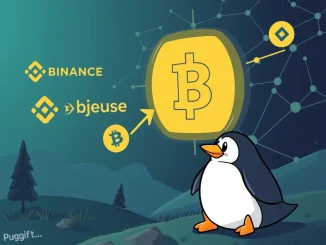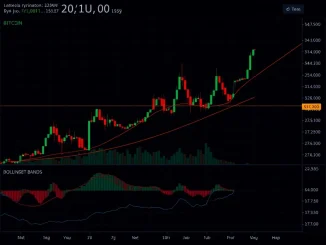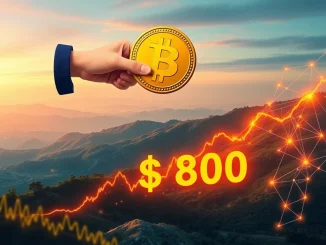
Hey there, crypto enthusiasts and finance curious! Have you heard the buzz about Real World Assets (RWA) tokenization? It’s not just hype; the numbers are truly staggering. A recent report cited by Cointelegraph, based on data from Binance Research, reveals that the RWA tokenization market has experienced an absolutely massive surge this year. We’re talking about growth exceeding 260%, catapulting the market value from a significant $8.6 billion at the start of the year to an impressive $23 billion currently.
What Exactly is RWA Tokenization?
Before we dive deeper into the surge, let’s quickly cover what RWA tokenization means. Simply put, it’s the process of issuing a digital token on a blockchain that represents ownership or a fractional stake in a tangible or intangible real-world asset. Think of things like real estate, art, commodities, company equity, or even debt and credit. Instead of holding a physical deed or a traditional paper certificate, you hold a secure, verifiable token on a blockchain.
Real World Assets Go Digital: The $23 Billion Milestone
The jump from $8.6 billion to $23 billion isn’t just a statistic; it represents a significant shift in how value is being represented and traded. This rapid expansion highlights growing confidence and adoption of blockchain technology beyond native cryptocurrencies like Bitcoin and Ethereum. It signals that institutions and investors are increasingly looking at bringing illiquid or traditionally complex assets onto the blockchain for the benefits it offers.
Here’s a quick look at the growth:
- Start of Year Value: ~$8.6 billion
- Current Value: ~$23 billion
- Growth Percentage: Over 260%
This kind of growth trajectory in any market is noteworthy, but seeing it in the nascent field of tokenized Real World Assets underscores its potential.
Driving Forces: Which Tokenized Assets Are Leading the Boom?
According to the Binance Research report, the primary engines behind this substantial growth have been specific types of Tokenized Assets:
- Tokenized Private Credit: This involves representing private debt obligations as tokens on a blockchain. It can offer more transparency and potentially faster settlement compared to traditional private credit markets.
- Tokenized U.S. Treasury Debt: Representing ownership in U.S. government debt (like Treasury bills or bonds) as tokens. This provides a way for crypto holders and others to gain exposure to stable, yield-bearing traditional finance assets directly on the blockchain.
While other asset classes are also being explored for tokenization, these two areas have seen particularly rapid adoption, contributing significantly to the market’s overall size increase.
How is Blockchain Technology Fueling This Transformation?
At its core, this surge is powered by Blockchain technology. Blockchain provides several key advantages that make tokenizing real-world assets appealing:
- Increased Liquidity: Tokenization can break down large assets (like a building) into smaller, fractional tokens, making them easier to buy and sell.
- Greater Transparency: Transactions are recorded on an immutable public ledger, providing clear ownership trails (though privacy layers can be added where needed).
- Enhanced Efficiency: Eliminates intermediaries and automates processes through smart contracts, potentially reducing costs and settlement times.
- Accessibility: Allows a broader range of investors, both large and small, to access asset classes that were previously difficult or expensive to invest in.
Beyond the Numbers: Benefits and Challenges of RWA Tokenization
The benefits are clear: increased access, efficiency, and liquidity for asset owners and investors. However, like any emerging market, challenges exist.
Key Benefits:
- Fractional Ownership: Own a piece of a high-value asset.
- 24/7 Trading: Unlike traditional markets, blockchain operates around the clock.
- Reduced Costs: Fewer intermediaries mean lower fees.
- Global Access: Easier for international investors to participate.
Potential Challenges:
- Regulatory Uncertainty: Frameworks are still developing in many jurisdictions.
- Legal enforceability: Ensuring token ownership translates legally to asset ownership.
- Valuation Issues: Accurately valuing the underlying real asset.
- Integration: Bridging the gap between traditional finance systems and blockchain.
What This Crypto Market Growth Signifies for Investors and Institutions
This dramatic Crypto market growth driven by RWAs indicates a maturing ecosystem. It shows that blockchain isn’t just for speculative digital currencies; it’s a powerful infrastructure for representing and managing traditional value. For investors, it opens up new avenues for diversification and yield. For institutions, it offers potential for increased efficiency, new funding mechanisms, and access to global capital pools. It suggests a future where the lines between traditional finance and decentralized finance (DeFi) become increasingly blurred.
Looking Ahead: The Future of Real World Assets on Blockchain
Binance Research points out that clearer regulatory frameworks will be crucial for the continued expansion of this sector. As rules become more defined, we can expect even greater participation from major financial players. The potential for tokenizing a vast array of assets, from real estate and infrastructure to intellectual property and carbon credits, is immense. The $23 billion market size today could just be the tip of the iceberg.
Conclusion: A New Era for Asset Ownership
The surge in RWA tokenization is one of the most exciting developments in the blockchain space right now. The market’s jump over 260% this year, fueled by tokenized private credit and U.S. Treasuries, highlights the practical utility and growing adoption of blockchain technology for representing Real World Assets. While challenges remain, particularly around regulation, the trajectory suggests a future where tokenized assets play a significant role in global finance, offering unprecedented liquidity, transparency, and accessibility. Keep an eye on this space – it’s just getting started!



